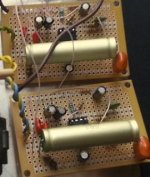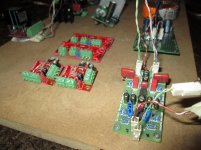I don't know, the TT platter should be some kind of aluminium alloy. It's a Pioneer PL-516X.Sounds like magnetic interference with the cartridge, maybe. Is the TT platter ferrous metal?
Cartridge tracks at 2g, anti skating is set to 2 as well. Cartridge was aligned using the Stevenson protractor.
Last edited:
Sounds like magnetic interference with the cartridge, maybe. Is the TT platter ferrous metal?
What?!?
Errr... sound like his opamps are oscillating.
Go for your built in RIAA and then get some hints when you try to rebuild the Elliot06 RIAA.
What?!?
Errr... sound like his opamps are oscillating.
Go for your built in RIAA and then get some hints when you try to rebuild the Elliot06 RIAA.
Really, you shouldn't act superior. I have heard this happen some time ago from a ferrous platter mat running past the cartridge. Sounded exactly as described; a whistling, wind sound that faded when you lifted the arm away from the platter.
Last edited:
Sorry Stuey, didn't mean to come off as snooty. Cheers, Mate!
What you describe sounds so ... sneaky, I can't imagine trying to trouble shoot that and then finally discovering what it was. It must have been fun!
I'm reading this differently, constant whistling that's more noticeable when music's not playing.
Given the pic of the PCB with the distant hf and electrolytic bypass caps, I went with my own experience with opamp oscillation. Get the hf caps right next to the opamp and the electros close behind.
Tell us more djduck.
Cheers,
Jeff
What you describe sounds so ... sneaky, I can't imagine trying to trouble shoot that and then finally discovering what it was. It must have been fun!
I've also noticed that there is this weird noise in the output sometimes that sounds almost like wind in a microphone. Can't really notice it with music playing but with the tonearm up, it's pretty apparent.
I've just spent hours listening to it, currently spinning some Modern Talking, with my AKG K14HDs through the big amplifier and I really like the sound.
I'm reading this differently, constant whistling that's more noticeable when music's not playing.
Given the pic of the PCB with the distant hf and electrolytic bypass caps, I went with my own experience with opamp oscillation. Get the hf caps right next to the opamp and the electros close behind.
Tell us more djduck.
Cheers,
Jeff
Last edited:
No worries, I'm sure you're more close to the mark. Mine was indeed a very unusual thing, probably unique to the cart as well, a Grado of some kind.
Stuey, Grado carts are known for humming and causing other anomalies on certain turntables. IIRC, there is a list somewhere on teh interwebs of turntables that Grado carts work with.
I'll relocate filter caps tomorrow and we'll see what happens.
Meanwhile, I've been spending a lot of time with vinyl and the AT95E is getting it's burn-in and I really like how this cart sounds with the Elliot 06 🙂
Tomorrow I might drop by the electronics store and pick up a few different op-amps to roll.
Also the 470n caps did help. When I tap my desk with the turntable on it, a low frequency "thump" can still be heard, but the woofers are not exactly flapping around in the wind anymore.
I'll relocate filter caps tomorrow and we'll see what happens.
Meanwhile, I've been spending a lot of time with vinyl and the AT95E is getting it's burn-in and I really like how this cart sounds with the Elliot 06 🙂
Tomorrow I might drop by the electronics store and pick up a few different op-amps to roll.
Also the 470n caps did help. When I tap my desk with the turntable on it, a low frequency "thump" can still be heard, but the woofers are not exactly flapping around in the wind anymore.
By the way, I have an Elliott P06 which has seen some use (I purchased Rod's board) and I quite like it. I also noticed a fair bit of cone movement and expected if I used it in the future to need some sort of filter, as indicated above and by Mr Elliott.
Yeah, I knew about Grado and hum. This was a swirling whistle, solved by removing the platter mat, which was a laminated steel/rubber affair. It wasn't mine, so I have little detail about the mat itself.
Yeah, I knew about Grado and hum. This was a swirling whistle, solved by removing the platter mat, which was a laminated steel/rubber affair. It wasn't mine, so I have little detail about the mat itself.
Can you show us the bottom so we can see the gnd?

The opamps may be oscillating for two main reasons.
Opamp PS
Solder the hf ps bypass caps (~100nF) directly to the socket pins and gnd as short as possible.
Put the lf ps bypass caps (~100uF, electros) close and as short as possible to gnd.
Feedback network
Solder the feedback res (180k, 100k) directly to the socket pins and as short as possible. (You could even go Surface Mount, a 1206 or 805 will fit right between adjacent pins)
Solder the other feedback res (4.7k, 2.7k) directly to the socket pins, then directly to the fb electros (22uF) and then directly to gnd (again all leads as short as possible.)
Arrange the rest of the parts around this, again as close and short as possible.
That should fix any tendencies towards oscillation.
Cheers,
Jeff

The opamps may be oscillating for two main reasons.
Opamp PS
Solder the hf ps bypass caps (~100nF) directly to the socket pins and gnd as short as possible.
Put the lf ps bypass caps (~100uF, electros) close and as short as possible to gnd.
Feedback network
Solder the feedback res (180k, 100k) directly to the socket pins and as short as possible. (You could even go Surface Mount, a 1206 or 805 will fit right between adjacent pins)
Solder the other feedback res (4.7k, 2.7k) directly to the socket pins, then directly to the fb electros (22uF) and then directly to gnd (again all leads as short as possible.)
Arrange the rest of the parts around this, again as close and short as possible.
That should fix any tendencies towards oscillation.
Cheers,
Jeff
Last edited:
Alright, thanks Jeff!
I'll do it when I have time, I'm kind of busy right now. I might buy new boards and resistors, etc, and just do a new build.
I'll do it when I have time, I'm kind of busy right now. I might buy new boards and resistors, etc, and just do a new build.
...
Your interest made my dig mine out!
View attachment 455532
😉
Ah yes, I used my sweet OPA2132P for this!
...
Mmmm,


... but darn, gotta pull it out to fix my 2nd riaa rolloff ... 🙁
- Status
- Not open for further replies.
- Home
- Amplifiers
- Chip Amps
- My first DIY phono stage - need advice!